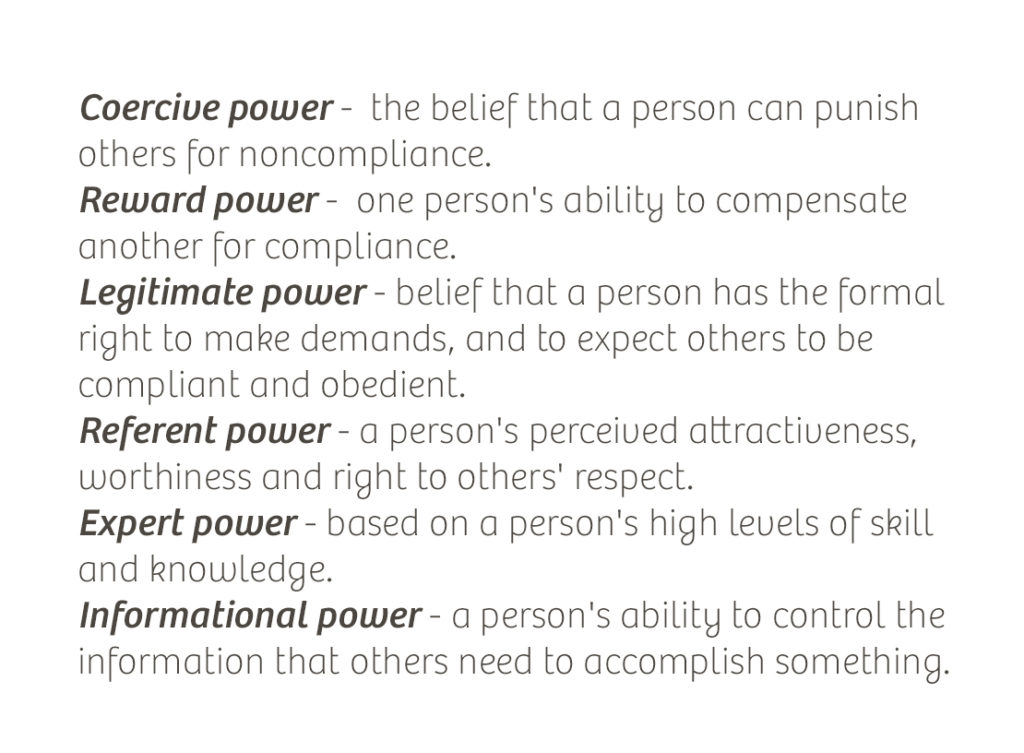What It Is:
French and Raven’s Five Bases of Power is a model that identifies different sources or types of power that individuals or leaders may use to influence others. This model was formulated in 1959 by social psychologists John French and Bertram Raven.
The Five Bases of Power:
- Legitimate Power:
- This power is based on a person’s position or authority within an organization. It is the power that comes with a formal title or role, and individuals in higher positions may have the authority to influence those in lower positions.
- Coercive Power:
- Coercive power is based on the ability to punish or control others. Individuals who possess coercive power can use threats, punishments, or negative consequences to influence or control the behavior of others.
- Reward Power:
- Reward power is derived from the ability to provide rewards, benefits, or positive outcomes. It involves the use of incentives, such as promotions, raises, or praise, to influence others.
- Referent Power:
- Referent power is based on the personal characteristics and qualities of the person. It involves individuals being influenced by someone they admire, like, or want to be like. Charismatic leaders often possess referent power.
- Expert Power:
- Expert power is rooted in an individual’s knowledge, skills, or expertise. People are influenced by those who are perceived as experts in a particular field or domain. This type of power is associated with competence and credibility.
Context and Development:
The Five Bases of Power were developed in the context of understanding social influence and leadership dynamics within organizations. French and Raven aimed to categorize the various ways individuals can exert influence over others, recognizing that power is a multifaceted concept.
The model was formulated during a time when organizational psychology and leadership studies were gaining prominence. It was a response to the need for a comprehensive framework to analyze and understand the dynamics of power and influence in social settings, particularly within the context of work and organizations.
How to Use It:
Understanding the bases (or types) of power is valuable in leadership and management contexts. Leaders can assess and leverage different bases of power depending on the situation and individuals involved. It also provides insights into how power dynamics can impact group dynamics, decision-making processes, and organizational effectiveness.
Using Types of Power in Agile Coaching:
- Understanding Team Dynamics:
- Help the Agile software delivery team understand the different types of power and how they may manifest within the team. Foster discussions around the positive and negative aspects of each type.
- Promoting Legitimate Power:
- Encourage team members to respect legitimate power within the team, such as the authority of the Scrum Master, Product Owner, or other role-defined positions. Ensure that decisions align with the roles and responsibilities of team members.
- Rewarding Positive Contributions:
- Use reward power positively by recognizing and rewarding team members for their contributions and achievements. This can boost morale and motivation.
- Mitigating Coercive Power:
- Discourage the use of coercive power within the team. Foster an environment where collaboration and open communication are valued over punitive measures.
- Building Referent Power:
- Encourage team members to develop referent power by building strong relationships, demonstrating empathy, and cultivating a positive team culture. A positive team culture often relies on the influence of referent power.
- Valuing Expertise:
- Recognize and value expertise within the team. Empower team members to share their knowledge and skills, contributing to a collaborative and high-performing environment.
- Sharing Information:
- Promote informational power through transparent communication and the sharing of relevant information. A well-informed team is more likely to make informed decisions.
Understanding the bases of power is essential for leaders, coaches, and individuals in organizational settings to navigate and influence effectively within the complex dynamics of human relationships. The key is to leverage power dynamics in a way that promotes a healthy and productive team environment.
References:
- Original Research:
- “The Bases of Social Power” by John R.P. French Jr. and Bertram Raven, published in 1959, in the journal “Studies in Social Power”, the seminal work that introduced the six types of social power. Reading the original paper provides a comprehensive understanding of their framework.
- Psychology Textbooks:
- Textbooks on social psychology or organizational behavior often cover the Five Bases of Power and their applications in leadership and influence.
- Leadership Literature:
- Books on leadership may discuss the different types of power and how leaders can effectively use them.
Visit the Agile Coach’s Toolkit for more definitions, models, theorems and stuff.

